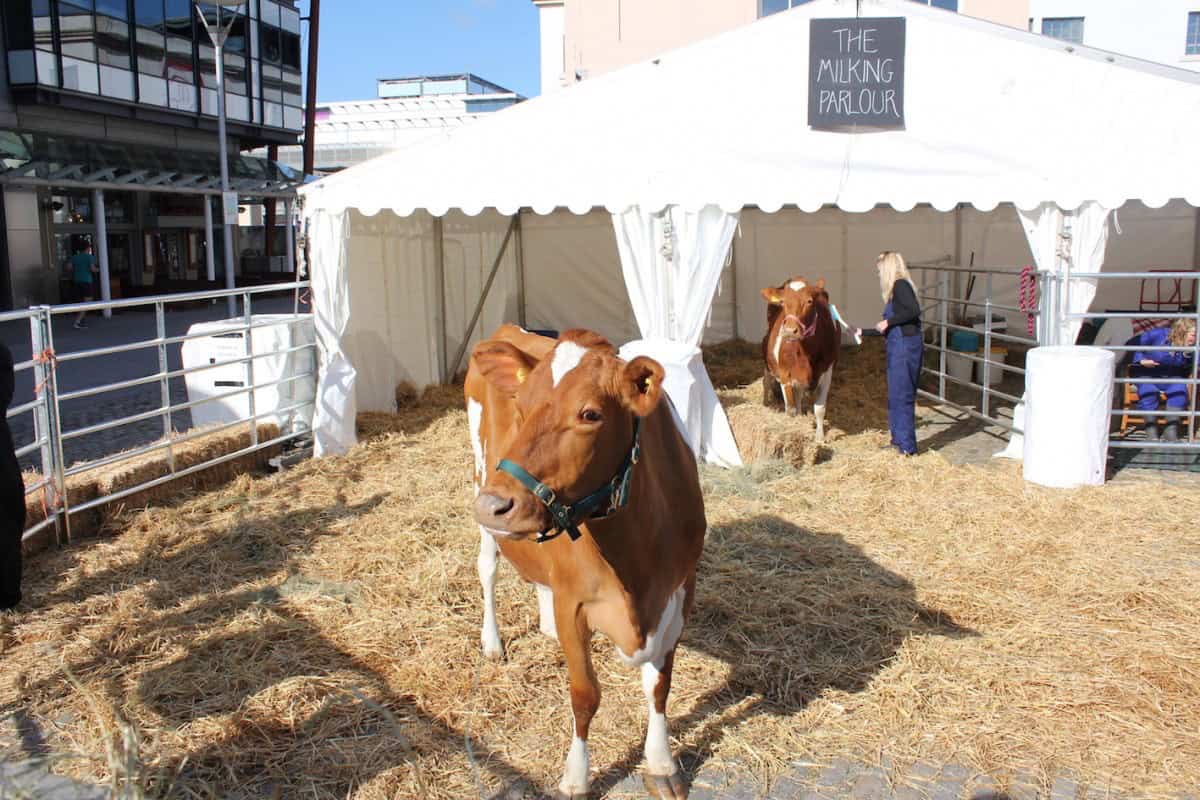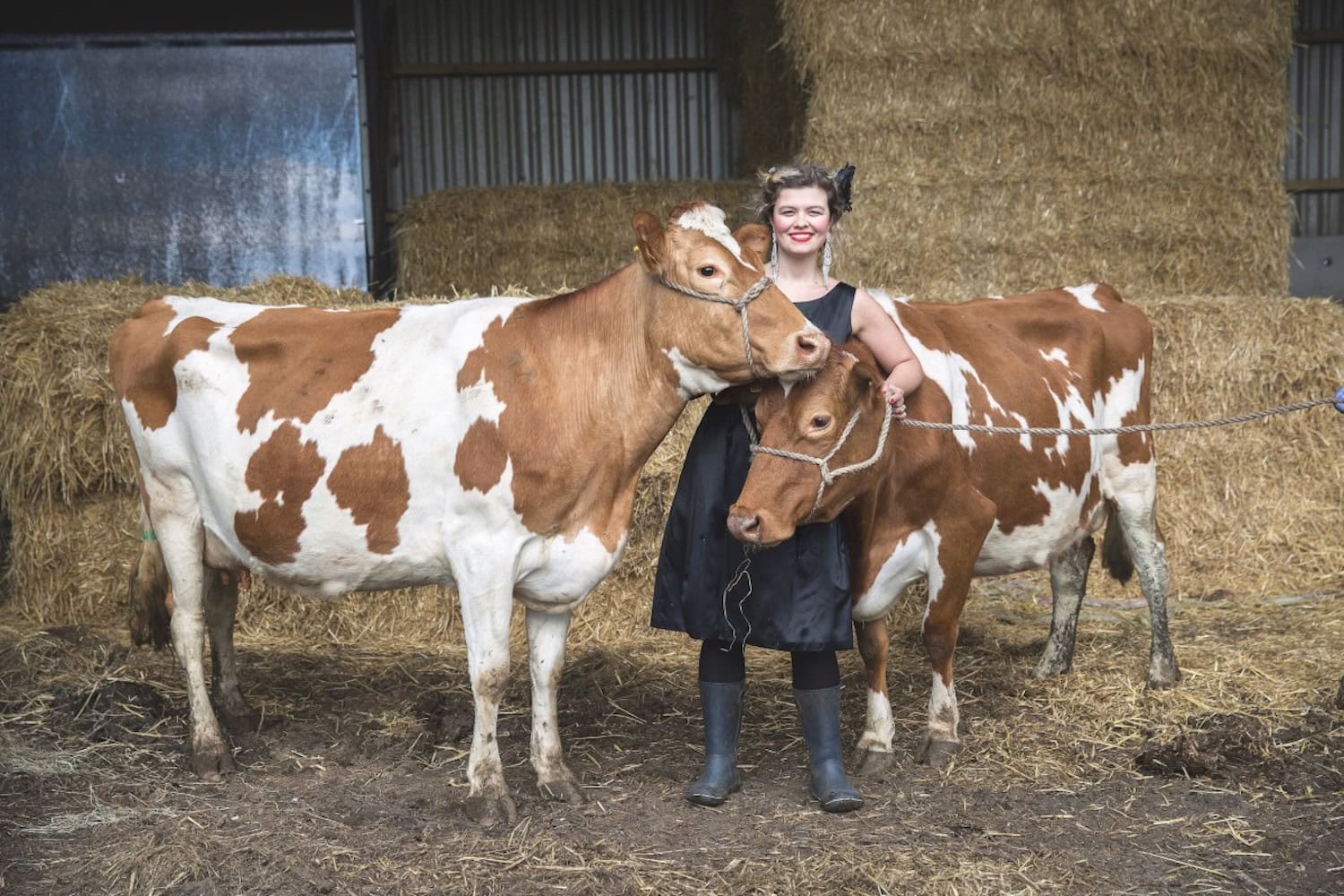Discovering that milk can be cheaper than water left a sour taste in the mouth of artist Nessie Reid. She explains why she turned to performance art to challenge the modern dairy industry
From her bed she could still feel the warmth of the two animals. She had grown used to their slightly acrid odour, the gentle sound of their chewing, even the coarse hair that had worked its way into her sheets.
Earlier this year, Nessie Reid spent five days living in close quarters with two Guernsey cows. The performance, The Milking Parlour, which took place in the centre of Bristol, was part art, part activism and part love story.
Reid shared a straw-strewn pen with the show cows Meadowsweet and Alisa, each day milking them, mucking out the space and feeding them in full view of the public. The arrangement was not unlike the temporary sleeping arrangements farmers adopt during calving season to watch over their charges. In this intimate set up, Reid found herself growing ever more attached to the cows’ quiet nature, and more committed to highlighting the problems inherent in what she calls an “increasingly defunct” food system.
“I was looking for a subtle way to talk about our relationship to food,” explains Reid. “I wanted to get people to think and talk about where their food comes from.”
The first performance of The Milking Parlour in April hosted live discussions around the ethics of food production and gathered and displayed handwritten responses from the public. It also led to some of the 5,000 or so people who visited making lifestyle changes, according to Reid.

In a bid to reach as many people as possible, Bristol’s Harbourside, one of the most frequently visited parts of the city, was selected as the setting for the performance. “I specifically wanted to reach a broad demographic – not the typical organic milk-drinking middle class,” Reid explains.
The exhibition was in part motivated by her horror at the awareness that milk prices had dropped below the cost of water. Reduced international demand, a surplus in production and fierce competition by supermarkets have all contributed to historically low prices in milk in the UK in recent years.
But while Reid agrees that consumers help fuel tumbling prices of dairy products – linked to farmers receiving rock bottom returns and poor conditions for animals – she puts this down to a lack of understanding rather than deliberate disregard. “I think that people care, but often they feel they don’t have a choice, so they feel disempowered. I would hope that by giving people more information and more solutions, they can become more engaged.”
When we have an embodied physical experience, we relate to it more strongly
The Milking Parlour is part of Reid’s residency at Cape Farewell, an international collaboration between artists, writers and musicians to respond in interesting cultural ways to climate change. It is hoped that the creative expression of the crisis on a more ‘human scale’, might better connect with those not compelled by science alone.
Reid is now preparing to display her exploration of the food system in exhibition format (this time without the cows) at Durlston Country Park in Dorset, for three weeks in November. She is then on to Latvia with the Imagine 2020 – Art and Climate Change network. Here, she will lead workshops with residents, farmers, artists and chefs. In June 2017, The Milking Parlour, complete with Meadowsweet and Alisa, will set up at Bridport Arts Centre for another live performance.
Why do live performances reach people where articles and reports sometimes cannot? “When we have an embodied physical experience, we relate to it more strongly,” suggests Reid.
“Images of slaughterhouses or fibreglass cows wouldn’t have had the same impact. People could smell the cows, see them peeing and pooing, and see me milking them, as well as get a sense of the connection I had with the animals. I would rather give that direct experience to a few thousand people than to a million who couldn’t connect to it.”
While for health and safety reasons, people were not supposed to touch the cows, some children proved unable to resist. The tactile connection offered a more compelling lesson than words alone could, says Reid. “I think that seeing these incredible beasts – they are such amazing creatures – affected people. Cows have a kind of patience that can make you feel incredibly present.”
Cows have a kind of patience that can make you feel incredibly present
While the response to the project has not been wholly positive – animal rights activists protested the use of animals in the Bristol performance, and what they saw as the condoning of an exploitative dairy industry – it did earn Reid a People Environment Achievement (PEA) award in October.
Founder Jarvis Smith explained that the awards recognise people who make a stand in order to champion sustainable solutions. Smith believes the awards, now in their sixth year, demonstrate the power of ordinary people’s actions.
And Reid, who defines herself as a political ecologist and artist, agrees: “There is a lot that civil society can do. It’s crucial to realise that we have great agency. Placing blame is tempting as an activist, but I feel like we need to work from a heart space as well, rather than just a campaigning stance.”

Nessie with cows Meadowsweet and Alisa
Reid has just begun a nine-month fellowship at St Ethelburga’s Centre, a hub in London for work around reconciliation and peace, in order to research how spirituality could be applied to environmentalism. She is also spending much of her time in west Wales after falling in love with an organic dairy farmer who is based there. This means plenty more opportunities to spend time with the bovine creatures that stole her heart in Bristol.
“Nothing is more relaxing than being in a field of cows and hearing them munch munching away,” she says.
Images: Cape Farewell
